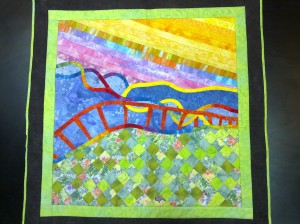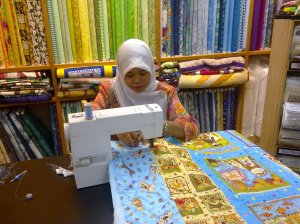New Straits Times, May 26, 2007 | by Yeang Soo Ching
HAVE time on your hands? Why not take up quilting? Even if you have never held a needle in your life, you can learn to create beautiful stuff you’d be proud to show off, writes YEANG SOO CHING.
Harvinder Kaur Gill is happiest when she’s dreaming about colours and designs, materials and thread. Very complex dreams, you might say. But to her, they couldn’t be happier realms she has floated to. All that visualisation is put on to material, and voila! They turn into beautiful quilts!
“Quilting is about putting three layers of fabric and batting together. Batting is an insulation layer to give stability and texture to the material and at the same time to keep you warm. Batting can be cotton, polyester, wool or silk. If I just put fabric together, it is called patchwork. But if I put fabric, stitching and batting together, it becomes a quilt,” the cheerful Harvinder explains.
Waxing lyrical about her passion for quilting, she says it calms the mind and enables one to learn about oneself.
“You see, when you’re cutting the material, you have to visualise the design and you have to focus. It is self-actualisation to design, to draw and to create a quilt. Even when you’re at the final stages, your mind is still focused on the number of stitches needed.
There was a study by an American craft group which measured the blood pressure of a group of quilters before they started. Half an hour into quilting, their blood pressure dropped,” Harvinder shares.
Anyone can learn quilting. There is no gender bias, she adds. After six basic lessons, a beginner can complete a queen-size quilt.
He or she can then move on to more intricate projects, such as wall hangings, bags and wearable art such as jackets and travel vests with hidden pockets. Pregnant women can do a whole “baby” series: bibs, towels, bedsheets and organisers, for example.
There are two types of quilts: machine and hand. While many people find it therapeutic to quilt by hand, others, especially those with a “fast and furious” temperament, prefer to machine their quilts. To each his own, Harvinder says. Both types will still yield the same beautiful results.
“After six basic lessons, my students can interpret a book by themselves. After 12 lessons, they acquire more quilting techniques. As they go on, they will pick up more complicated techniques. There is really no time frame that says you have learned it all because there will always be new techniques, new cutting tools, more complicated machines. It is a continuous learning curve,” says Harvinder.
Even after 12 years of teaching the craft, she still makes an annual visit to the United States to update her knowledge. She learnt craft design and technology in Britain and pursued a Retailers University Programme in the United States.
She even took up a Teaching Methodology course to enable her to teach students on demand, according to their own pace.
“In a mixed class where students are at different stages of progress, you need to know about teaching methodology in order to manage the class well.
That is why I take a maximum of five students per class. If the students are fast, they learn more. If they prefer a more relaxed pace, they can focus on learning skills.”
Harvinder assures that even if you have never held a needle before, you will still be able to make a luxurious bedspread, attractive vest, jacket or eyecatching wall displays. The beginners usually get hooked and discover their artistic talent. If you’re already a competent craftsperson, you can still pick up sophisticated, advanced sewing techniques.
Harvinder sells all the tools you will need, including fabrics, kits, books and accessories. The basic tools are:
* Rotary cutter: This tool can cut 16 layers of fabric at one go.
* Specialty ruler: This is specially-designed for quilting and has measurements as well as angles on it.
* Rotary cutting mat: This is a base for cutting so you don’t destroy the table.
* Long pins: Basic quilting tools.
* Quilting thread: Basic quilting tools.
Classes are from Wednesday through Sunday, with two sessions scheduled from 11am to 1pm and from 2pm to 4pm.
Quilt Gallery is located at LG18, Lower Ground Floor, Bangsar Village 1, Jalan Telawi Satu, Bangsar Baru, Kuala Lumpur. Tel: 03- 2282-5789 and fax: 03-2284-5799.
Different techniques
IF you want to try quilting, take note of the following different types of classes you can opt for:
1) Basic patchwork and quilting: Learn from the very basic to advanced techniques. Course fees are RM200 for six sessions.
2) Marti’s Town:
Come design your own township. Learn a different setting and use all your scraps to make this colourful quilt. RM200 for six sessions.
3) Machine quilting made easy:
This class teaches how and when to use a walking foot and provides extensive practice in free motion quilting. Techniques for preparing your quilt top for machine quilting, and choosing quilting thread, needles, batting, marking tools and quilting patterns will be discussed. RM200 for six sessions.
4) Hand quilting workshop:
This class teaches the fine points of hand quilting, techniques and equipment. RM200 for six sessions.
5) Kitchen crafts:
Table mats, oven mitts, table napkin, coasters, table runner and anything else you can think up for your kitchen and dining room. RM200 for six sessions.
6) Wearable art:
Design and create a special vest or dressy jacket for yourself. RM200 for six sessions.
Contact Gill at new email quiltgallerykl@yahoo.com
New Website www.quiltgallery.com.my

Visit our New Website!
- Quilt Gallery – Home
Your Beginner Friendly Sewing Store…


